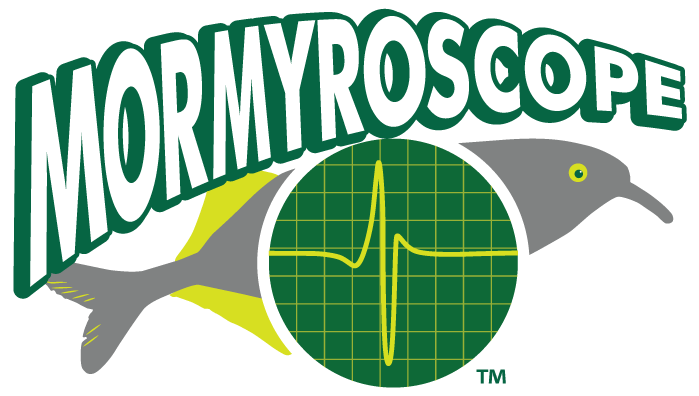
Mormyroscope is the first publicly available software application specifically designed for making digital recordings of electric fishes. The application is a customized version of Soundcard Scope software written and published by Christian Zeitnitz, Professor of Physics at Wuppertal University, Germany. It is free for non-commercial educational and scientific use. This program will run on Windows 2000/XP/Vista/7/8/10/11 (32 bit and 64 bit) computers and tablets. It will not install on older versions of Windows.
The download link is here: LINK
Mormyroscope offers all the features of Soundcard Scope while adding specimen- and recording-specific file names and metadata to the output files. It has an interface in both English and French and a cool logo you see above by JaeCreative.
Mormyroscope is intended to be used with an external USB audio interface (="sound card") using an electrode plugged into the mic input of the device.
Waveforms are visualized in an oscilloscope window that offers all the controls of a standard oscilloscope. Waveform snapshots (one millisecond to several milliseconds in duration) are saved simultaneously as jpeg image files and .csv data files from which data can be plotted and superimposed in a spreadsheet or graphing application. Before saving files, the user is prompted to enter metadata associated with the specimen, the recording, the project name & the recordist. These data are written to a header in the .csv file and also written to a separate .txt file. Recordings of long trains of EOD pulses of several seconds to several minutes can be saved as .wav files in the Recorder window of Mormyroscope. Metadata are also embedded in the header of the wav file.
A poster presented at the 2018 PAFFA conference in Malawi in which we describe this setup is available here. Also see How to record EODs and other related articles here on this blog.
The English language manual for the regular version of Soundcard Scope is available here.
An updated version with bug fixes was uploaded on 19 September 2019.
Important: before running Mormyroscope on your Windows PC, be sure to install the appropriate driver recommended by the manufacturer of your audio interface. Then make sure that your computer recognizes the device and it is selected for audio input in Settings --> System --> Sound app, or in the Sound Control Panel. Also make sure the interface is acquiring data at its fastest rate, e.g. 192 kHz if it's capable. We have had issues with individuals making recordings corrupted by "Gibbs Effect" ringing artifacts. This issue disappears when the correct driver is intalled and sample rate is set for 192 kHz. We can confirm that the Focusrite 2i2 3rd Gen audio interface works well for recording when the appropriate Focusrite driver is installed and the recording is made at 192 kHz.
Please let us know if you find Mormyroscope useful and if you have suggestions to improve it!
Development of Mormyroscope was made possible by the MbiSa Congo I (2013-2018) project, a framework agreement project of the Royal Museum for Central Africa, Tervuren, Belgium, with funding from the Belgian Development Cooperation.
- Team Mintotom




Comments
taxinomie des marcusenius du pool malebo, kinshasa
je cherche à décrire les Marcusenius du pool malebo et faire la différence avec ceux de l’Afrique austral en utilisant les caractères morphologique, étude moléculaire et la DEO. Je cherche aussi à faire la différence entre le code barre de Marcusenius monteiri et Marcusenius stanleyanus et utilisant les marcaires nucleaire. Cette étude sera complétée par l’écologie et la biologie de ces espèces pour contribuer à leur exploitation durable.
Locating and biology and ecology of mormyrids
Hello John!
I'm a biologist from South Africa - www.riversoflife.co.za and have been collecting some mormyrids in our region I want to expand our ability to find and understand these fishes without using nets/electrofishers. Going to build a amplifier and give it a go. With my post-grads I'd like to have a chat about their biology, ecology and what we can do to contribute to understanding our local species.
Thanks, cheers
Gordon
Locating and biology and ecology of mormyrids
Hi Gordon. My apologies for this late reply: I didn't get a notification about your message. Sounds like a wonderful project. Good luck with the amplifier. I have found another, commercially avaiable one that's an alternative to the now hard-to-find Radio Shack amplified speaker. it's the Danelectro Honeytone N-10 Mini Guitar Amp. https://bit.ly/39fznCD I bet you can get it in South Africa. You should get in touch with Albert Chakona at SAIAB in Grahamstown who is pursuing various projects on mormyrids and who has some experience recording their EODs.
Good luck and stay in touch!
Best,
John
Add new comment